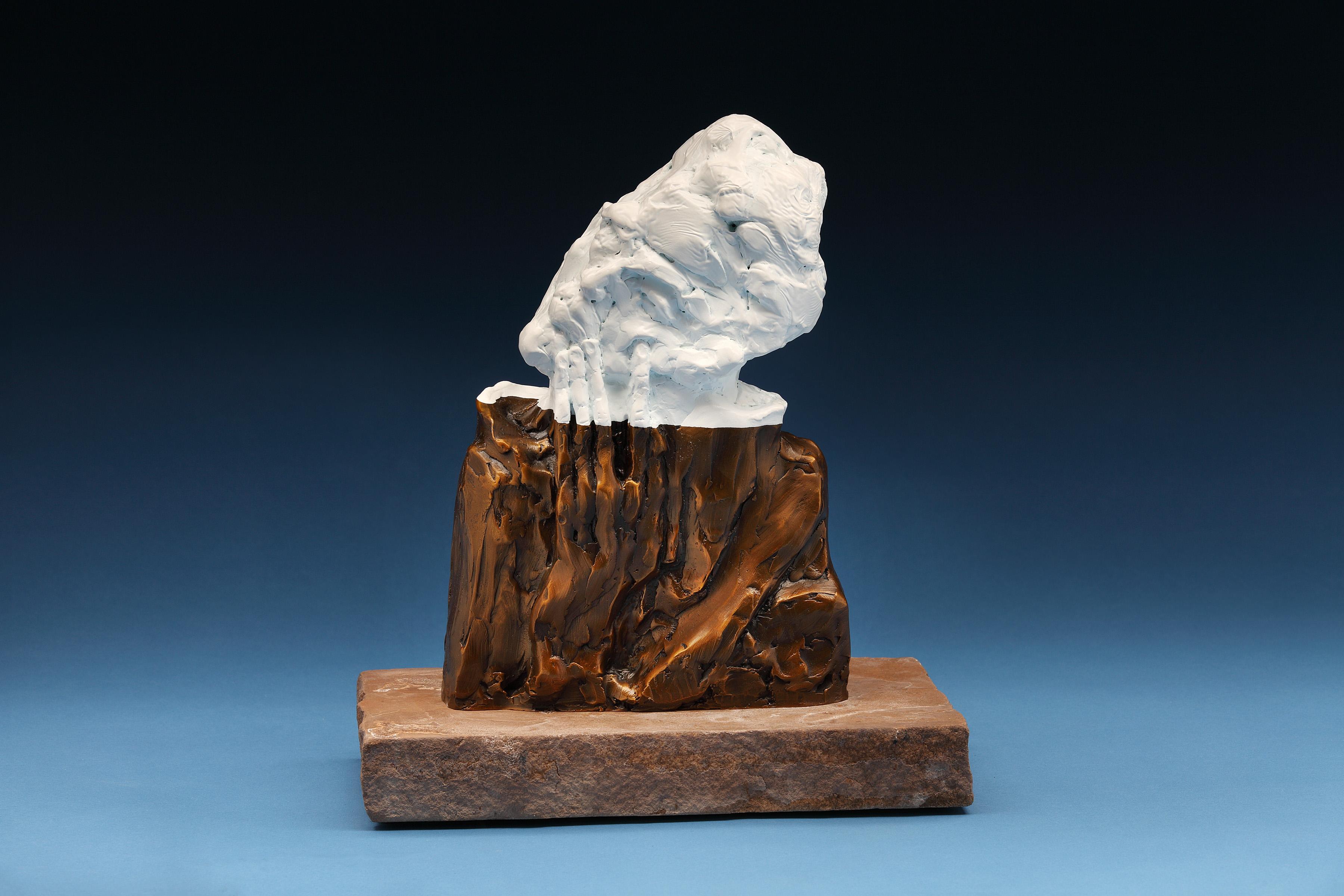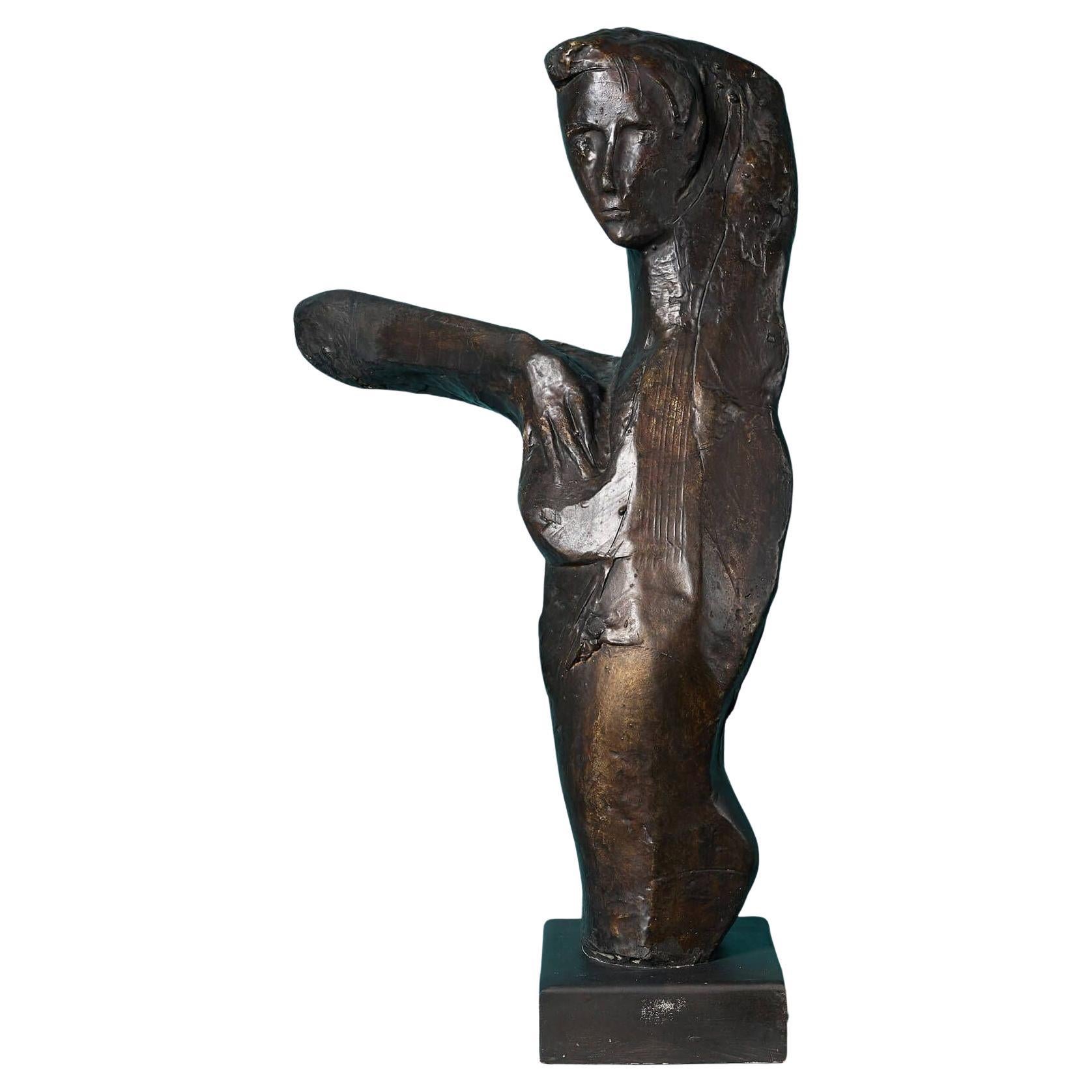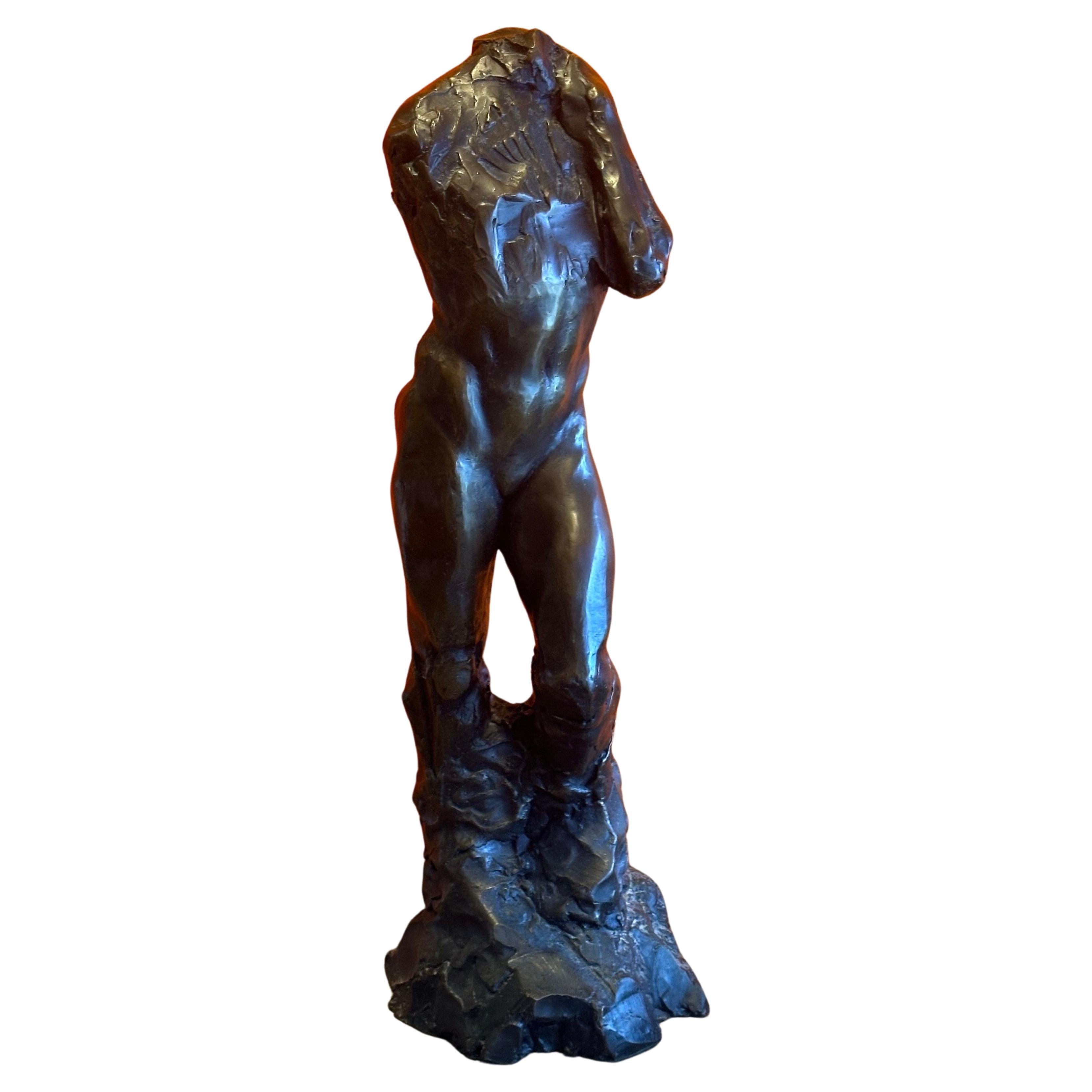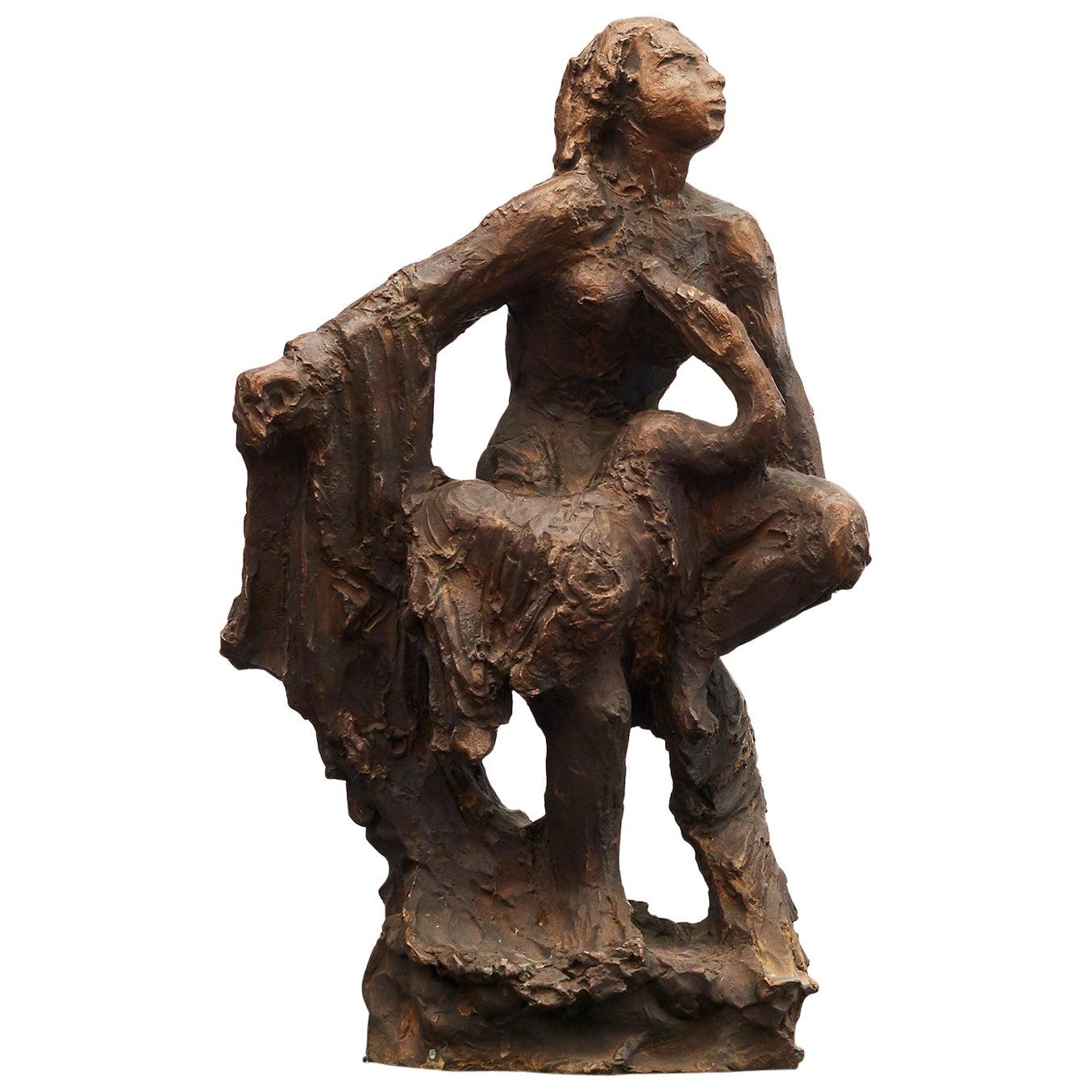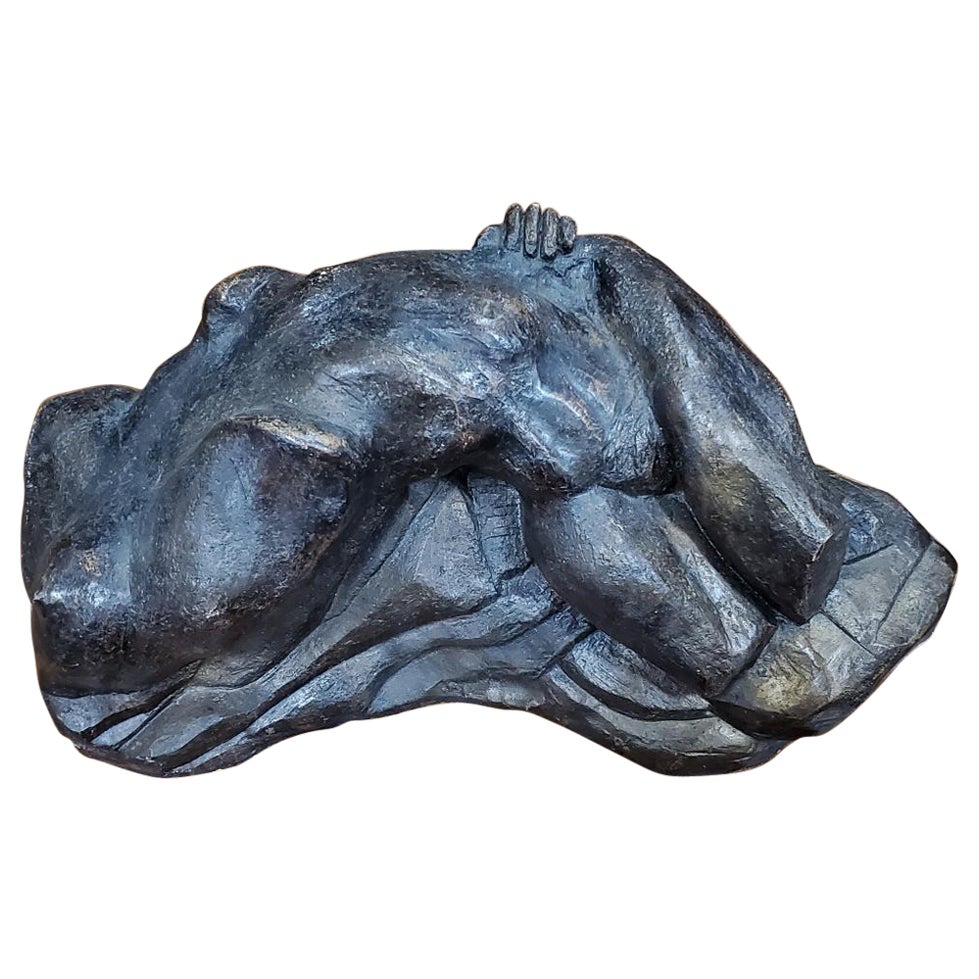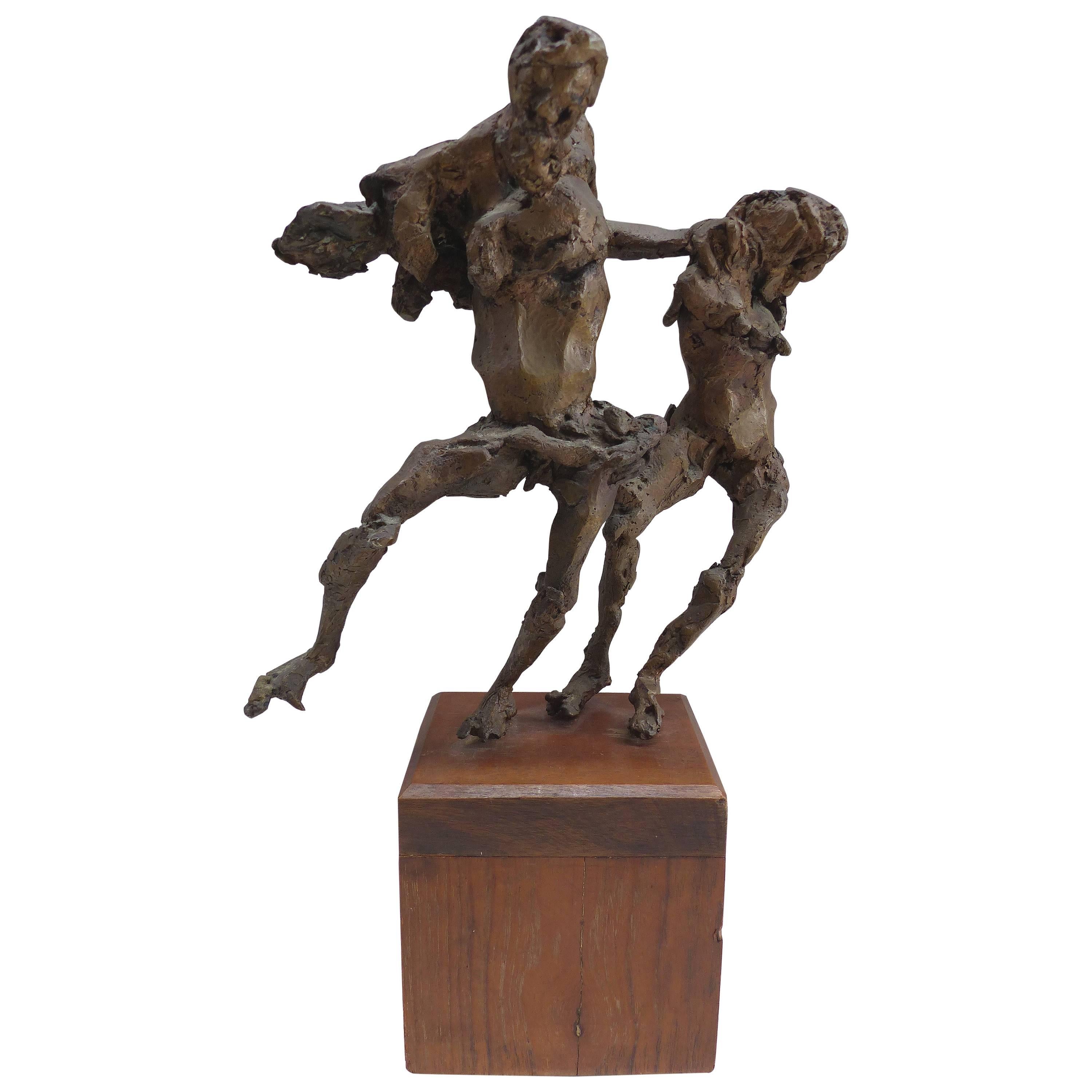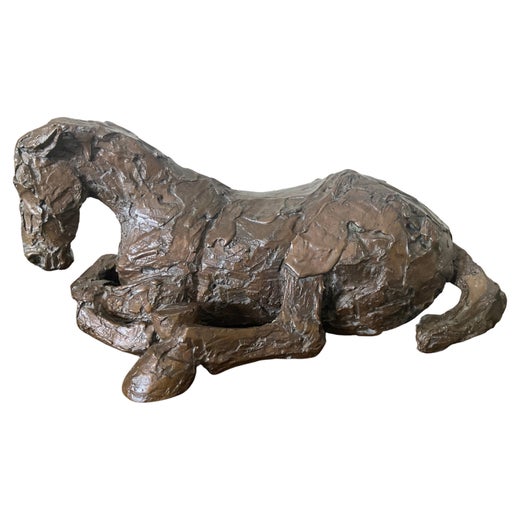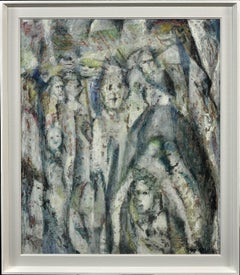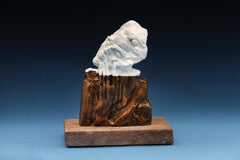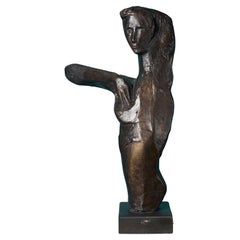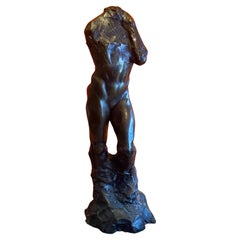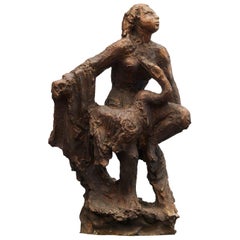Items Similar to Dame Elisabeth Frink Bronze Relief Statue Of Man And Eagle Numbered 1/7 Maquette
Want more images or videos?
Request additional images or videos from the seller
1 of 21
Elisabeth FrinkDame Elisabeth Frink Bronze Relief Statue Of Man And Eagle Numbered 1/7 Maquette1967
1967
$44,885.39
£32,985
€38,548.07
CA$62,069.77
A$67,578.15
CHF 36,084.58
MX$815,774.08
NOK 453,647.70
SEK 421,945.15
DKK 287,935.31
About the Item
Dame Elisabeth Frink.
English ( b.1930 - d.1993 ).
Maquette For Man And Eagle.
Bronze With Gold Brown Patina.
Signed And Numbered 1/7 Lower Left.
Size 8.7 inches x 10.2 inches ( 22cm x 26cm ).
Depth 2.8 inches ( 7cm ).
Weight 7.1lb ( 3.24KG).
Available for sale; this original bronze plaque with raised relief is by Dame Elisabeth Frink and was conceived and cast in 1967.
The maquette is presented and supplied unmounted. There is the option to hang the plaque from 2 rings applied to the rear when in previous ownership.
This vintage bronze plaque / statue is in very good condition with a uniform gold brown patina overall.
The maquette is signed and numbered 1/7 lower left.
Literature:
B. Robertson, Elisabeth Frink Sculpture: Catalogue Raisonné, Salisbury, 1984, pp. 170-171, no. 158, as 'Bronze plaque (maquette for Man and Eagle Relief)'
A. Ratuszniak, Elisabeth Frink: Catalogue Raisonné of Sculpture 1947-93, Farnham, 2013, p. 106, no. FCR183, as 'Bronze plaque (maquette for Man and Eagle Relief)'.
The photographs featured here have been taken with a selection of tungsten and fluorescent light so as to provide a varying contrast so as to pick out the features and textures.
Dame Elisabeth Frink was one of Britain’s most important post-war sculptors, an accomplished draughtsman, illustrator and teacher. She was part of the post-war school of expressionist British sculptors dubbed the Geometry of Fear, and enjoyed a highly acclaimed career that was commercially successful, broke boundaries and contributed greatly to bringing wonderful sculpture to public places.
She was born on 14 November 1930 in Thurlow, the daughter of a cavalry officer, and brought up in rural Suffolk near to an active airbase. She was brought up a Catholic and educated at the Convent of the Holy Family, Exmouth.
She then studied at the Guildford School of Art from 1947-1949 under Willi Soukop and Henry Moore’s assistant, Bernard Meadows, and then at the Chelsea School in London 1949-1953. She taught at Chelsea School of Art 1951-61, St. Martin’s School of Art 1954-62 and was a visiting instructor at the Royal College of Art 1965-1967, after which she lived in France until 1973.
Frink first came to the attention of the public in 1951 at an exhibition at the Beaux Arts Gallery, London. In 1952 she represented Britain at the Venice Biennale, being described by Herbert Read as “the most vital, the most brilliant and the most promising of the whole Biennale”. The same year the Tate bought its first work by her, and she began to enjoy commercial success. Thereafter she exhibited regularly and was for 27 years associated with Waddington’s, London.
The subjects which Frink was most concerned with were man, dog and horses, with and without riders. Interestingly she seldom sculpted the female form, drawing on archetypes of masculine strength, struggle and aggression. Her work has the recurring themes of the vulnerable and the predatory, in the spirit of an authentic post-war artist. It has been said that she was more concerned with representing mankind that portraits of individuals.
The appeal of her work lies in its directness, provoking a frank statement of feeling. The anatomy is often exaggerated or incorrect; the impact growing more out of her interest in the spirit of the subject. Her animals and birds may be drawn from nature but verge on the abstract, conveying raw emotion and character rather than a realistic depiction. Her unique style is characterised by a rough treatment of the surface which embeds each piece with vitality and her personal impression. In her later work even the distinction between human and bird figures becomes blurred. Commentators have noted that the often rugged, brutal and contorted surfaces of her work reflect the destruction and terror of the six-year world-wide conflict that she witnessed as a child. Frink was an active supporter of Amnesty International.
In the 1960s and early 1970s Frink produced a notable series of falling figures and winged men. Later, living in France during the Algerian war, she began making heads, blinded by goggles which had a threatening facelessness.
Frink produced many notable public commissions, including Wild Boar for Harlow New Town, Blind Beggar and Dog for Bethnal Green, Noble Horse and Rider for Piccadilly, London, a lectern for Coventry Cathedral, Shepherd for Paternoster Square beside St. Paul’s Cathedral and a Walking Madonna for Salisbury Cathedral. In the early 1980s she produced a set of three larger than life figures The Dorset Martyrs which stand on the edge of the old walled town of Dorchester on the site of the old gallows, as a memorial to those who had been executed there ‘for conscience sake’.
Frink’s Canterbury Tales was a collection of 19 etchings drawn directly on to copper plates and etched by her. The ‘book’ was issued in three limited editions. Her illustrations have been praised as “amongst the most successful illustrations of the century, encompassing the mood of the text in concise delineations and disarmingly ribald humour”. She illustrated other books with coloured lithographs or drawings.
Frink was on the Board of Trustees, British Museum from 1976, and was a member of the Royal Fine Art Commission 1976-81. CBR (1969), DBE ((1982), Associate of the Royal Academy (1971), Royal Academy (1977). She was made a Companion of Honour in 1992. She died on 18 April 1993, but not before completing her last commission, a monumental but unusual figure of Christ for the front of the Anglican Cathedral in Liverpool, unveiled a week before her death.
For several decades Frink exhibited widely in the UK and abroad. In her later years she lived and worked in Dorset where her garden became an arena for her work.
In 1985 she had a retrospective at the Royal Academy. She died on 18 April 1993, but not before completing her last commission, a monumental but unusual figure of Christ for the front of the Anglican Cathedral in Liverpool, unveiled a week before her death. There was a memorial show at Yorkshire Sculpture Park, Bretton Hall in 1994.
Today Frink is venerated as one of the great twentieth century British sculptors. Her unique work is represented in the Tate Gallery and major public and private collections world-wide.
© Big Sky Fine Art
This bronze maquette with gold brown patina was produced by Frink for the work Man and Eagle Relief. It is signed and numbered 1 of 7. Conceived and cast in 1967. It depicts the heavy standing figure of a man in the top left corner, bearing down towards a second naked figure, who is seated and looking away. In the bottom right hand corner there is the head of a huge eagle, its outstretched wing reaching over the head of the seated figure as if in a protective gesture.
- Creator:Elisabeth Frink (1930-1993, British)
- Creation Year:1967
- Dimensions:Height: 8.67 in (22 cm)Width: 10.24 in (26 cm)Depth: 2.76 in (7 cm)
- Medium:
- Movement & Style:
- Period:
- Condition:This vintage bronze relief sculpture is in very good condition with a uniform gold brown patina overall.
- Gallery Location:Sutton Poyntz, GB
- Reference Number:1stDibs: LU489314075212
Elisabeth Frink
Dame Elisabeth Jean Frink was an influential English sculptor and printmaker whose work captured the complexities of the post-war era. Born in Thurlow, Suffolk, she studied at Guildford School of Art (1946–1949) under Willi Soukop, and at Chelsea School of Art (1949–1953). Frink emerged as a key figure among the Geometry of Fear sculptors, a group of post-war British artists including Reg Butler, Bernard Meadows, Kenneth Armitage, and Eduardo Paolozzi. Her oeuvre encompassed themes of masculinity, strength, and struggle, frequently depicting men, birds, dogs, and horses but rarely female forms. Her powerful sculptures and prints evoke the raw emotional aftermath of war. Frink's early years in wartime Suffolk left a profound impression on her art. She gained international recognition at the 1952 Venice Biennale, where Herbert Read hailed her as "the most vital, the most brilliant and the most promising" artist of the event. Her early success, such as Bird (1952, Tate, London), showcased her distinctive approach, blending menace and grace in avian forms. Her innovative bronze sculptures, characterised by rugged, worked surfaces, broke with traditional modelling techniques. The 1960s and 1970s marked a period of experimentation. While living in France, she produced the monumental Goggled Heads, haunting male figures exuding threat and alienation. Returning to England, her focus shifted to male nudes with powerful, barrel-chested forms and textured surfaces, exemplified by Running Man (1976, Carnegie Museum of Art). In the 1980s, Frink's career reached new heights. A retrospective at the Royal Academy in 1985 cemented her legacy, despite a demanding schedule that included major commissions like Dorset Martyrs in Dorchester. She continued to work tirelessly, contributing to public art projects, mentoring students, and serving on advisory committees. Even after being diagnosed with cancer in 1991, Frink persisted in her creative endeavors, producing her final monumental work, Risen Christ for Liverpool Cathedral, installed just days before her death on April 18, 1993. Frink's impact on sculpture extends beyond her life. Notable works like Warhorse and Walking Madonna are displayed at Chatsworth House, while Desert Quartet (1990) earned Grade II* listing in 2007, a rare honor for a contemporary piece. Her commitment to figurative art inspired the creation of the Frink School of Figurative Sculpture in 1996, a tribute to her artistic vision. David Bowie counted her among his favorite artists, owning several of her works. As Frink herself believed, sculpture transcends function, existing as an independent and sacrosanct object, harmonising with its environment while commanding a profound presence—a philosophy vividly embodied in her enduring legacy.
About the Seller
5.0
Vetted Professional Seller
Every seller passes strict standards for authenticity and reliability
Established in 2010
1stDibs seller since 2016
124 sales on 1stDibs
- ShippingRetrieving quote...Shipping from: Sutton Poyntz, United Kingdom
- Return Policy
More From This Seller
View AllHawk Bird Of Prey Framed Original Mid 20th Century Powerful Watercolor Painting
By Elisabeth Frink
Located in Sutton Poyntz, Dorset
Dame Elisabeth Frink.
English ( b.1930 - d.1993 ).
Hawk, 1969.
Watercolor.
Signed & Dated Lower Right.
Image size 25.4 inches x 19.5 inches ( 64.5cm x 49.5cm ).
Frame size 34.4 inches x 28.1 inches ( 87.5cm x 71.5cm ).
Available for sale; this original painting is by Dame Elisabeth Frink and is dated 1969.
The painting is presented and supplied in a glazed frame and mount dating from June 1997.
This vintage watercolor is in very good condition, commensurate with its age.
The watercolor is signed and dated lower right.
Previously with Beaux Arts, London and Bath in 1999.
Dame Elisabeth Frink was one of Britain’s most important post-war sculptors, an accomplished draughtsman, illustrator and teacher. She was part of the post-war school of expressionist British sculptors dubbed the Geometry of Fear, and enjoyed a highly acclaimed career that was commercially successful, broke boundaries and contributed greatly to bringing wonderful sculpture to public places.
She was born on 14 November 1930 in Thurlow, the daughter of a cavalry officer, and brought up in rural Suffolk near to an active airbase. She was brought up a Catholic and educated at the Convent of the Holy Family, Exmouth.
She then studied at the Guildford School of Art from 1947-1949 under Willi Soukop and Henry Moore’s assistant, Bernard Meadows, and then at the Chelsea School in London 1949-1953. She taught at Chelsea School of Art 1951-61, St. Martin’s School of Art 1954-62 and was a visiting instructor at the Royal College of Art 1965-1967, after which she lived in France until 1973.
Frink first came to the attention of the public in 1951 at an exhibition at the Beaux Arts Gallery, London. In 1952 she represented Britain at the Venice Biennale, being described by Herbert Read as “the most vital, the most brilliant and the most promising of the whole Biennale”. The same year the Tate bought its first work by her, and she began to enjoy commercial success. Thereafter she exhibited regularly and was for 27 years associated with Waddington’s, London.
The subjects which Frink was most concerned with were man, dog and horses, with and without riders. Interestingly she seldom sculpted the female form, drawing on archetypes of masculine strength, struggle and aggression. Her work has the recurring themes of the vulnerable and the predatory, in the spirit of an authentic post-war artist. It has been said that she was more concerned with representing mankind that portraits of individuals.
The appeal of her work lies in its directness, provoking a frank statement of feeling. The anatomy is often exaggerated or incorrect; the impact growing more out of her interest in the spirit of the subject. Her animals and birds may be drawn from nature but verge on the abstract, conveying raw emotion and character rather than a realistic depiction. Her unique style is characterised by a rough treatment of the surface which embeds each piece with vitality and her personal impression. In her later work even the distinction between human and bird figures becomes blurred. Commentators have noted that the often rugged, brutal and contorted surfaces of her work reflect the destruction and terror of the six-year world-wide conflict that she witnessed as a child. Frink was an active supporter of Amnesty International.
In the 1960s and early 1970s Frink produced a notable series of falling figures and winged men. Later, living in France during the Algerian war, she began making heads, blinded by goggles which had a threatening facelessness.
Frink produced many notable public commissions, including Wild Boar for Harlow New Town, Blind Beggar and Dog for Bethnal Green, Noble Horse and Rider for Piccadilly, London, a lectern for Coventry Cathedral, Shepherd for Paternoster Square beside St. Paul’s Cathedral and a Walking Madonna for Salisbury Cathedral. In the early 1980s she produced a set of three larger than life figures The Dorset Martyrs which stand on the edge of the old walled town of Dorchester on the site of the old gallows, as a memorial to those who had been executed there ‘for conscience sake’.
Frink’s Canterbury Tales was a collection of 19 etchings drawn directly on to copper plates and etched by her. The ‘book’ was issued in three limited editions. Her illustrations have been praised as “amongst the most successful illustrations of the century, encompassing the mood of the text in concise delineations and disarmingly ribald humour”. She illustrated other books with colored lithographs or drawings.
Frink was on the Board of Trustees, British Museum from 1976, and was a member of the Royal Fine Art Commission 1976-81. CBR (1969), DBE ((1982), Associate of the Royal Academy (1971), Royal Academy (1977). She was made a Companion of Honour in 1992. She died on 18 April 1993, but not before completing her last commission, a monumental but unusual figure of Christ for the front of the Anglican Cathedral in Liverpool, unveiled a week before her death.
For several decades Frink exhibited widely in the UK and abroad. In her later years she lived and worked in Dorset where her home and garden became an arena for her work.
In 1985 she had a retrospective at the Royal Academy. She died on 18 April 1993, but not before completing her last commission, a monumental but unusual figure of Christ for the front of the Anglican Cathedral in Liverpool, unveiled a week before her death. There was a memorial show at Yorkshire Sculpture Park, Bretton Hall in 1994.
Today Frink is venerated as one of the great twentieth century British sculptors. Her unique work is represented in the Tate Gallery and major public and private collections world-wide.
© Big Sky Fine Art
This original watercolor on paper painting of a hawk by Dame Elizabeth Frink...
Category
Mid-20th Century Modern Animal Paintings
Materials
Paper, Watercolor
Vows Are Spoken Only To Be Broken Circa 1965 The Flip Hairstyle Cornish Nude
Located in Sutton Poyntz, Dorset
Tony Giles.
English ( b.1925 - d.1994 ).
Vows Are Spoken Only To Be Broken.
Oil On Board.
Signed Lower Right.
Image size 39.6 inches x 29.5 inches ( 100.5cm...
Category
Mid-20th Century Modern Nude Paintings
Materials
Oil
Moonlight Embrace Male & Female Nude En Grisaille Watercolor Picasso Influence
Located in Sutton Poyntz, Dorset
Keith Bayliss.
Welsh ( b.1954 ).
Moonlight Embrace.
Watercolor & Ink.
Signed Lower Left.
Image size 10.4 inches x 14.4 inches ( 26.5cm x 36.5cm ).
Frame size 16.7 inches x 20.1 inc...
Category
Late 20th Century Constructivist Nude Drawings and Watercolors
Materials
Paper, Ink, Watercolor
Enigma 1960s Eccentric And Bohemian Framed Original Welsh Abstract Oil Painting
By Meryl Watts
Located in Sutton Poyntz, Dorset
Meryl Watts.
English ( b.1910 – d.1992 )
Enigma.
Oil On Board.
Signed Lower Right.
Image size 22.4 inches x 19.3 inches ( 57cm x 49cm ).
Frame size 26.4 inches x 22.8 inches ( 67cm x 58cm ).
Available for sale; this original oil painting is by Meryl Watts and dates from the mid-1960s.
The painting is presented and supplied in its’ original hand painted frame (which is shown in these photographs).
This vintage painting is in very good condition, commensurate with its age. It wants for nothing and is supplied ready to hang and display.
The painting was created whilst Watts resided at 1 Bron Avon, Borth-y-Gest, Porthmadog. (Today’s postcode would be LL49 9TU).
The painting is signed lower right.
Meryl Watts was born on the 5th April 1910, the only child of Charles and Evelin Watts. They lived in Germains Place, Blackheath and she was raised in east end of London where her father was a printer.
She studied at the Blackheath Art School, where the Principal was John Edgar Platt, one of the major artists using the technique of color woodcut. She learned this technique from Platt and was influenced by his style, as shown in the attractive and colorful designs that she subsequently produced.
Meryl began to work independently in 1937, producing her own work while still living in Blackheath. During World War II the family home and business were destroyed by German bombing and Meryl and her parents were given just a few hours to collect whatever valuables they could before their house was demolished to protect neighboroughing properties from further damage. As a consequence much of her early work was lost.
Having left their home the family evacuated to Portmeirion in Wales, where they had frequently stayed on holiday before the war. They struck up a friendship with the Portmeirion architect and founder, Sir Clough William-Ellis. Portmeirion was founded in 1925 and took nearly fifty years to complete. It was a homage to Sir William-Ellis’ love of the Italian Riviera and incorporated the grounds of a twelfth century castle. The resort became extremely popular with tourists and was the backdrop for various TV programs and films, including The Prisoner. Meryl Watts became artist in residence at Portmeirion, and over the next few years she produced an abundance of artwork including sketches, oil paintings and watercolors of famous scenes from the Snowdonia coastal region and other traditional landmarks. This was a new and very successful chapter of her artistic career.
From Portmeirion Meryl and her parents moved to a rented house in Borth-Y-Gest, Caernarvonshire, North Wales. In 1944 Meryl’s father purchased the house and Meryl began to work there, using the endless views in the area for her inspiration. After the death of her father in 1957 and her mother in 1969 Meryl lived alone in Borth-y-Gest until she married Professor Joseph Allen...
Category
Mid-20th Century Abstract Abstract Paintings
Materials
Oil, Board
The Thief Framed Symbolist & Expressionist Pastel Artwork Magpie Black & White
By Julian Ruddock
Located in Sutton Poyntz, Dorset
Julian Ruddock.
British ( b.1965 ).
The Thief.
Pastel On Paper.
Signed Lower Left.
Image size 29.1 inches x 21.3 inches ( 74cm x 54cm ).
Frame size 38.4 inches x 29.9 inches ( 97.5c...
Category
Late 20th Century Symbolist Animal Drawings and Watercolors
Materials
Paper, Pastel
A Liberated Lady On The Cliffs Nude Sunbathing Framed 1920s French Oil Painting
Located in Sutton Poyntz, Dorset
Raymond Moritz.
French ( b.1891 - d.1950 ).
A Liberated Lady On The Cliffs, 1927.
Oil On Canvas.
Signed Lower Left.
Image size 25 inches x 20.7 inches ( 63.5cm x 52.5cm ).
Frame size 29.3 inches x 24.8 inches ( 74.5cm x 63cm ).
Available for sale; this original oil painting is by the French artist Raymond Moritz and dates from 1927.
The painting is presented and supplied in a sympathetic contemporary frame (which is shown in these photographs), mounted with new fixtures.
The canvas and the painted surface have benefitted from cleaning and conservation, which was performed on our instruction, supervision and approval.
This vintage painting is now in very good condition. It wants for nothing and is supplied ready to hang and display.
The painting is signed lower left.
A later dedication to “Louise” dated April 1942 in the artist’s hand is set around the earlier signing.
Raymond Moritz was a French impressionist artist and illustrator. He was born in Paris on 8 July 1891. His family came from the Alsace region and were poor and Catholic. On his mother’s side, the Staubs were from Wihr-au-Val where they had been coopers for several generations. His uncle, Marie Clement Staub, was the founder in Canada of the Sisters of Saint Joan of Arc.
Moritz fought during the Great War in the Picardy region of the Somme with the 2nd machine gunner company. He won the French 1914-1918 War medal with bronze palm attachment, which signifies that the awardee was mentioned in dispatches at army level. Moritz obviously created some art during the war because during the inauguration of the new town hall in the town of Albert he was congratulated by the French President, Albert Lebrun, and the British press for the paintings he had produced. Albert was the main town behind the lines for the Allies on the Somme battle fields...
Category
Early 20th Century Art Deco Nude Paintings
Materials
Canvas, Oil
You May Also Like
Thinking Man, 13"high bronze
By Denny Haskew
Located in Loveland, CO
"Thinking Man" by Denny Haskew
Figurative Bronze (After Egon Schiele)
13x11x7" ed/15
"Thinking Man
puzzeled over this being
a flock of clouds
are in my head.
people are everywhere,
...
Category
2010s Contemporary Figurative Sculptures
Materials
Granite, Bronze
John W. Mills (1933-2023) Patinated Sculpture of Female Nude
Located in Wormelow, Herefordshire
A patinated resin maquette sculpture of a half length female nude by the acclaimed British sculptor, John W. Mills.
As a part of his female nude series, this piece depicts the figur...
Category
Mid-20th Century English Mid-Century Modern Figurative Sculptures
Materials
Resin
Large Figurative Bronze Sculpture Entitled "Adam's Rib" by Roark Congdon
Located in San Diego, CA
A large figurative bronze sculpture entitled "Adam's Rib" by Roark Congdon, circa 1990s. The piece is in very good condition with a great patin...
Category
Late 20th Century American Modern Figurative Sculptures
Materials
Bronze
Mogens Bøggild Bronze Sculpture "Leda and the Swan", Denmark, 1950-1960
By Mogens Bøggild
Located in Kastrup, DK
Mogens Bøggild. Bronze sculpture "Leda and the Swan", 1950-1960.
Dark patinated bronze. Signed with monogram 'MB'.
Mogens Kruse Bøggild (11 June 190...
Category
20th Century Danish Modern Figurative Sculptures
Materials
Bronze
David Segel Abstract Nude Sculpture Woman on Rocks, 1970s
By David Segel
Located in Monrovia, CA
DAVID SEGEL abstract nude sculpture woman on rocks 1970s.
1970s DAVID SEGEL abstract nude sculpture is a beautiful ceramic abstract. The Artist conveys his abstract view of the female human form with accentuated curves and muscular tones.
Artist used his female muse for many of his sculptures and paintings as seen in his works of art. As you can see there is much influence of French sculptors within this artists work yet the freedom of his own point of view.
This gorgeous abstract is quite substantial with a bronze tone to the ceramic sculpture.
This abstract is in excellent vintage condition with it's age. Again this piece has a bronze tone to the ceramic, and it is quite substantial.
ARTIST INFORMATION:
DAVID SEGEL 1921-2005:
An American Modernist Painter And Sculptor. He Lived In Venice California and Paris. After studying at the Carnegie Institute in Pittsburgh, and the Art Institute of Chicago, David moved to Paris in 1950 to work and teach, He studied in the atelier of Fernand Leger and then traveled around other Western European countries. He has been shown in galleries from Paris, France, to Los Angeles, California, including the Whitney Museum in New York City. Segel enjoyed a prolific career and worked with a variety of mediums including: oils, bronze and wood sculptures, and dramatic sketches. He also worked in furniture and interior design. Segel’s work is represented in the permanent collection of the Whitney Museum. His awards include The First Carnegie Prize and The Hallmark International Art Award. David Segel died in Venice, California in 2005 at the age of 84.
His solo exhibition of painting and sculpture include: Lynchburg, VA; Galerie Ariel, Paris; Galerie Maight, Paris; Van-Dieman Lilienfeld Gallery, New York; Palmer House...
Category
Late 20th Century American Organic Modern Figurative Sculptures
Materials
Ceramic
Linda Goodman Brutalist Bronze Figurative Sculpture
By Linda Goodman
Located in Miami, FL
Linda Goodman Brutalist Bronze Figurative Sculpture
Offered for sale is a Brutalist bronze sculpture by the American artist Linda Goodman (1910-2004). ...
Category
Mid-20th Century American Brutalist Abstract Sculptures
Materials
Bronze
More Ways To Browse
Bronze Relief
Sculpture Maquette
Bronze Maquette
Naked Figure
Mens Vintage French
Eagle Sculpture Art
Horse And Dog
Gold Eagle Sculpture
Plaque Ring
Bronze Relief Plaques
Vintage Goggles
Bronze Skier
Eagle Statue
Bronze Eagle Signed And Numbered
Life Size Bronze Horse Statues
Salisbury Cathedral
Bronze Statue Of Man
Virgen Caridad
